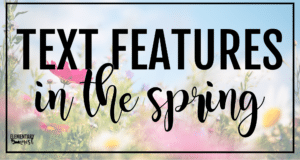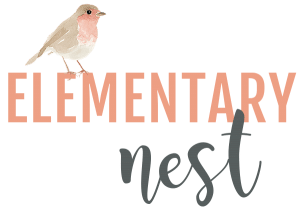
This isn’t the first time we’ve discussed using the current season as a way to make your ELA content more engaging. Adding the element of a current event, seasonal topic, specific interests, etc., can bring your normal ELA content a new life. Even if you’ve taught Text Features before, this will make it new and fresh! So, today I am going to talk about teaching nonfiction text features during the spring season.
Anchor Charts with a Spring Focus


First, when teaching any new content, I will always recommend creating anchor charts. For this theme, simply create or display an anchor chart that shows text features surrounding a spring item or topic. In this case, I chose a frog’s life cycle. It is always a plus when you can integrate what you’re learning in science or social studies with your ELA lessons.
For anchor charts, you can print images and text features and glue them onto your chart paper to create a large version of an article or informational text.
After you have an example with several text features, have your students help you label the text features with sticky notes! OR for a lower-prep option, bring up a PDF or webpage of an article on your smartboard. Then, you can label the features digitally!
You can even center this around spring activities that your class has planned. If you visit an arboretum, aquarium or a baseball stadium, your students can create their own anchor charts about a topic from the trip.
Mentor Texts with Examples


Simultaneously, switching out your stack of mentor texts with ones that fit the theme will create high-interest reading materials. Grab a few of these spring nonfiction books and have them available for your students to use during partner and independent activities. Below are a list of affiliate Amazon links:
- Plants: National Geographic Reader
- Everything Spring (Picture the Seasons)
- The Reason for a Flower: A Book About Flowers, Pollen, and Seeds (Explore!)
- Seed to Plant: National Geographic Reader
- Hop, Bunny! Explore the Forest: National Geographic Reader
- Plants in Spring (All About Spring)
- Cherry Blossoms Say Spring (National Geographic Kids)
- Caterpillar to Butterfly: National Geographic Readers
- Wiggling Worms at Work (Let’s-Read-and-Find-Out Science 2)
- What Can You See in Spring? (Seasons: Acorn)
- TIME For Kids Informational Text: A Frog’s Life – Grade 1
Nonfiction Text Features in Videos

Another option is looking for nonfiction text features in spring-themed videos. BrainPop & BrainPop, Jr. always have excellent examples of text features! Here are some of my favorite videos about spring!
- Butterflies
- Habitats
- Spring
- Water Cycle
- Reduce, Reuse, Recycle
- Parts of a Plant
- Plant Life Cycle
- Earth Day
- Solstice & Equinox
Practice in Passages


Of course, your students will need to practice finding text features in nonfiction passages. So, use texts about topics that fit in the spring category. These could be passages about spring holidays, the science of the season, weather, spring sports, butterflies, plants, and more!
Fun with Nonfiction Text Features

Once you find texts to work with, consider amping up the fun with extras that feel like spring! This can be extremely simple and low-prep. Have your students color-code nonfiction text features with spring markers. Add green, pink, and yellow sticky notes to their supply bins. Use spring-themed mini-erasers like butterflies, frogs, and flowers as markers or talking chips for group activities.
Whatever your theme ideas are, they will surely boost student engagement! I hope that you find some fun in the theme, as well!
Happy Spring Teaching!
Suggested Resource Focused on Nonfiction Text Features




If you’re looking for a set of passages that will fit all your spring nonfiction text features activities, I have a set for you! These 19 nonfiction texts each come with a page of skill-specific comprehension questions. Simply print and go!














